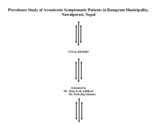Please use this identifier to cite or link to this item:
https://hdl.handle.net/20.500.14356/314Full metadata record
| DC Field | Value | Language |
|---|---|---|
| dc.contributor.author | Adhikari, Hom Jyoti | |
| dc.contributor.author | Ghimire, Tirth Raj | |
| dc.date.accessioned | 2012-12-31T16:59:12Z | |
| dc.date.accessioned | 2022-11-08T10:14:19Z | - |
| dc.date.available | 2012-12-31T16:59:12Z | |
| dc.date.available | 2022-11-08T10:14:19Z | - |
| dc.date.issued | 2008 | |
| dc.identifier.uri | http://103.69.126.140:8080/handle/20.500.14356/314 | - |
| dc.description.abstract | Summary: Arsenic contamination in drinking water has been a global concern. It has affected many countries of the world including India and Bangladesh. The Terai region of Nepal has similar geography to these countries and similar practice of extraction of groundwater for drinking. So, contamination of ground water with arsenic and prevalence of arsenicosis might be similar. The diseases chronic in nature and most of the time the patients do not have any symptom until they are detected through a screening survey. This study tries to diagnose arsenic case by common dermatological manifestations called melanosis and keratosis in combination with a history of consuming arsenic contaminated water. The general objective of the study was to find out the prevalence of arsenicosis symptomatic patients among the risk households in Ramgram Municipality, Nawalparasi, Nepal. The study was conducted from 26th June, 2007 to 28th July, 2007. This was a cross-sectional and descriptive study. Households exposed to 50 ppb to 350 ppb of arsenic concentration in drinking water were selected on the basis of blanket testing data of DWSS (2006). The tools applied were the questionnaires, direct observation, and interview. The Algorithm Chart produced by WHO, 2005 was followed for identifying arsenicosis symptomatic patients. Arsenic contents in hair and nail samples were determined by Atomic Absorption Spectrometer in ENPHO laboratory, Kathmandu. Data were analyzed by means of tables and diagrams, prevalence rate and percentage rate. Out of 866 populations studied, 28 people (3.2%) showed the symptoms of arsenicosis. The prevalence was 4.5% (17/379) in males and 2.3% (11/487) in females. The maximum prevalence of arsenicosis patients (8.8%) was in ward number 6; whereas, the maximum number of patients (14) was in ward number 8. The maximum prevalence of arsenicosis symptom was that of melanosis on trunks (71.4%) followed by Keratosis on palm (11.1%) and then by Keratosis on sole (7.4%). The maximum numbers of patients (14) showed mild orinitial state of arsenicosis. Majority of the arsenicosis symptomatic patients (82.1%, 23/28) replied that television, radio, newspapers, local students and educators were the good sources of knowledge about arsenic. Maximum numbersof patients (53.6%, 15/28) demanded for the maintenance of Kanchan filters and distribution of anti-arsenicosis drugs. Among the two hair and three nail samples from 5 patients, all these samples showed the arsenic concentration more than 2 mg/Kg. | en_US |
| dc.language.iso | en_US | en_US |
| dc.publisher | Nepal Health Research Council | en_US |
| dc.subject | Arsenicosis | en_US |
| dc.title | Prevalence Study of Arsenicosis Symptomatic Patients in Ramgram Municipality, Nawalparasi, Nepal | en_US |
| dc.type | Technical Report | en_US |
| Appears in Collections: | Post Graduate Grant (PG) Reports | |
Items in DSpace are protected by copyright, with all rights reserved, unless otherwise indicated.

